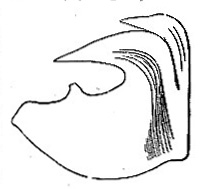1902 Encyclopedia > Annelida > I. Annelida Polychaeta: General Description. The Body. Cutaneous and Muscular Tissues.
Annelida
(Part 2)
I. Annelida Polychaeta
General Description. The Body. Cutaneous and Muscular Tissues.
I. In the first order, A. POLYCHAETA, the body (fig. 1) is elongated, segmented, more or less cylindrical (certain tubicolous forms having two well-marked (regions), and almost universally furnished with uniramous or biramous bristlebearing feet (parapodia, Huxley).

Fig. 1 -- Nereis pelagica. L. (After Oersted.)
The first segment is modified, so as to form a head or snout, and has the eyes, tentacles, &c. The second or buccal segment bears the mouth and certain processes. The other segments have foot-tubercles, bearing bristles developed in special sacks (e, fig. 4), and various appendages, such as elytra, dorsal and ventral cirri, &c.

Fig. 2 -- Bristle of Pionosyllis Malmgreni.
The structure of the bristles (e.g. fig. 2) holds a prominent part in the discrimination of species and even genera, and the same may be said of the hooks of many of the Tubicola (fig. 3).

Fig. 3 -- Hook of Terebella
A curious example of the Opheliidae has no bristles, and Tomopteris has only one at the base of each tentacle. Posteriorly, the diminished body generally terminates in two elongated cirri in the free forms, while in the sedentary such processes are often absent. In Polydora (fig. 21) a curious funnel-like structure exists.

Fig. 4 -- Transverse section of Eunice (After Ehlers.)
The body in the Polychaeta (e.g. fig. 4) is invested by a finely fibrous, cuticular, or chitinous later (d), to which the iridescence in many forms is due. This is perforated at somewhat regular intervals by two series of pores, and cilia are generally present at certain points. In the sedentary annelids the cuticle is thinner, a feature probably in connection with their protective tubes. Beneath the cuticle is a cellulo-granular hypoderm, with tubular glands, bacilliparous and glandular follicles in certain cases, as well as the deposits of pigment. The muscular system is well developed, and the bands variously arranged in the body-wall. A well-marked circular layer is generally present externally, while in others it would seem to be represented only by oblique bands. The longitudinal bundles follow different plans, such as forming an almost continuous coat, or split up into various distinct ribands (a and b, fig. 4, the former representing one of the dorsal bands, the latter one of the ventral). Schneider thought that the arrangement of the muscular system might form the basis of a classification of this and allied groups; but for sound reasons it has not been adopted. There is no tendinous raphe at each segment, though fibres from the dissepiments pass through the longitudinal layer, in some cases even to the hypoderm. The muscular fibres have a hyaline connective tissue. In Myxicola and Protula the fibres of the longitudinal coat have a dendritic appearance in transverse section. Besides the foregoing, many have a powerful oblique band on each side, passing down to be inserted near the nerve-cord, or elsewere; and the proboscis (a, fig. 5), bristles, branchiae, alimentary canal, and other organs, have a series of special muscles. By the muscles of the body-wall the Polychaeta execute all their movements in the water and on land, the feet-papillae with their bristles playing quite a subordinate part. A few progress in addition by special organs, such as the tentacles of the Terebellae.

Fig. 5 -- Ventral vascular system of Nereis cultrifera, Grube (After Ehlers). a, proboscis; a' ,oesophagus; a", intestine; b, dissepiments; v, vental blood vessel.
The cutaneous and muscular tissues enclose a space termed the perivisceral cavity, which stretches from the anterior to the posterior extremity. This chamber is lined by a special membrane, which likewise envelops the alimentary canal, vessels, and other organs. It is generally divided into various transverse spaces by muscular dissepiments or screens (which permit communication), and occasionally there longitudinal partitions. In this cavity the highly organized perivisceral corpuscles float in a coagulable lymoh, which has no relation with sea-water. The lining membrane is ciliated in Aphrodita, Glycera, Polycirrus, Tomopteris, and Terebella; and it is curious that in these the blood-vessels proper are absent, with the exception of the first and last. Ray Lankester has found that haemoglobin occurs in the perivisceral corpuscles of Glycera and Capitella. Professor Huxley, after M. de Quatrefages, is inclined to think the perivisceral fluid the true blood of the group, but this is doubtful.
Read the rest of this article:
Annelida - Table of Contents
|




